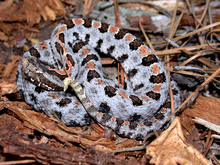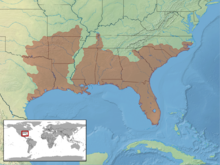Sistrurus miliarius
| Sistrurus miliarius | |
|---|---|

| |
| Scientific classification | |
| Domain: | Eukaryota |
| Kingdom: | Animalia |
| Phylum: | Chordata |
| Class: | Reptilia |
| Order: | Squamata |
| Suborder: | Serpentes |
| Family: | Viperidae |
| Genus: | Sistrurus |
| Species: | S. miliarius
|
| Binomial name | |
| Sistrurus miliarius (Linnaeus, 1766)
| |

| |
| Synonyms | |
|
List
| |
- Common names: pygmy rattlesnake, eastern pygmy rattlesnake, ground rattlesnake, leaf rattler, death rattler, more.[3]
Sistrurus miliarius, commonly called the pygmy rattlesnake, is a
Description

S. miliarius is a small species but bulky when it comes to width,[5] with adults usually growing to 40–60 cm (16–24 in) in total length (including tail). The maximum reported total length is 78.8 cm (31.0 in) (Klauber, 1972). Snellings and Collins (1997) reported a specimen of S. m. barbouri measuring 80.3 cm (31.6 in), but it had been in captivity for over 12 years. The largest S. m. barbouri reported by Gloyd (1940) was a specimen measuring 63.8 cm (25.1 in) from St. Petersburg, Florida. Shine (1978) suggested that in some populations, males may be larger than females, but a later study by Bishop et al. (1996) did not find sexual dimorphism of any kind in a population in Volusia County, Florida.[6] It is currently theorized that the lack of sexual dimorphism in the species is due to the fact that both males and females experience selective pressures to be of a larger size.[7]
At midbody, the rows of dorsal scales usually number 23. The dorsal pattern consists of a series of oval or subcircular spots with somewhat regular edges. The spots on the flanks are mostly round and not much higher than they are wide. Belly pigmentation towards the rear is more limited to indistinct blotches found on pairs of adjacent scales.[3] Juveniles' color patterns are similar to the adults, although they may be paler or more vividly marked, and the tips of their tails are yellow.[6]
Common names
Common names for S. miliarius include pygmy rattlesnake, ground rattlesnake, hog-nosed rattlesnake, little rattlesnake, miliar(y) rattlesnake, North American smaller rattlesnake, oak-leaf rattler, pygmy ground rattlesnake, small rattlesnake, southeastern ground rattlesnake, southern ground rattlesnake, southern pygmy rattlesnake, spotted rattler, spotted rattlesnake,[3] southern rattlesnake.[8] Older common names might include bastard rattlesnake, nipple snake, Carolina ground rattlesnake, brick red rattlesnake, Carolina pygmy rattlesnake, Catesby's small snake, dwarf rattlesnake, eastern pygmy rattlesnake, grey rattlesnake, and ground rattler (Garman, 1887).
Etymology
The specific name, miliarius, is derived from Latin and means millet or millet-like, perhaps referring to the blotched patterns described in the species.[9]
Geographic range

S. miliarius is found in the Southeastern United States from southern and eastern
Habitat
Sistrurus miliarius reportedly inhabits flatwoods, sandhills, mixed forests, and floodplains, and is also found near lakes and marshes.[2] Due to a need for cover pygmy rattlesnakes may prefer more densely vegetated areas.[10]
Conservation status
This species is classified as least concern on the
Behavior
S. miliarius is usually seen in the summer sunning itself or crossing the road late in the day. The tiny rattle makes a buzzing sound that can only be heard from a few feet away. The unusually small rattles of the pygmy rattlesnake is suggestive of the early stages of rattle evolution.
Feeding

The diet of S. miliarius includes small mammals and birds, lizards, insects, and frogs,[3] as well as other snakes.[16][17] Pygmy rattlesnakes also include giant desert centipedes in their diet, which they hunt by active pursuit, grabbing and flipping the centipedes around while simultaneously injecting venom to prevent injury by the victim. They also ambush lizards such as skinks by using their tails as lures, as is common in many other species of vipers.[22][23] Caudal luring becomes less effective for adults, as the prey size and type changes. Their feeding strategy becomes sit-and-wait, with individuals remaining in a coiled position for days at a time.[24] Pygmy rattlesnakes may change their foraging behaviors, such as prestrike, strike, and poststrike, to be most suitable for the prey item they are going after.[25]
Venom
Since S. miliarius is unable to produce much venom, it is unlikely to be able to deliver a fatal bite to a human adult.[26]
This snake produces
Subspecies
| Subspecies[4] | Taxon author[4] | Common name[29] | Geographic range[29] |
|---|---|---|---|
| S. m. barbouri | Gloyd , 1935
|
Dusky pygmy rattlesnake | Extreme southern South Carolina through southern Georgia, all of Florida, west through southern Alabama and southeastern Mississippi |
| S. m. miliarius | (Linnaeus, 1766) | Carolina pygmy rattlesnake | Extreme southern South Carolina, northwards into eastern North Carolina as far as Hyde County and west through central Georgia and central Alabama |
| S. m. streckeri | Gloyd, 1935 | Western pygmy rattlesnake | Mississippi (except for southeast of the Pearl River Valley), west through Louisiana into East Texas, and north into southeastern Oklahoma, Arkansas, southern Missouri, and southwestern Tennessee
|
Gallery
-
Carolina pygmy rattlesnake (S. m. miliarius)
-
Dusky pygmy rattlesnake (S. m. barbouri), Hendry Co., Florida (3 May 2013)
-
Western pygmy rattlesnake (S. m. streckeri), Wayne Co., Missouri (28 August 2015)
References
- ^ . Retrieved 2 April 2024.
- ^ ISBN 1-893777-00-6.
- ^ ISBN 0-8014-0463-0. (Sistrurus miliarius, pp. 1052-1061).
- ^ a b c d Sistrurus miliarius at the Reptarium.cz Reptile Database. Accessed 2 April 2024.
- ^ May, Peter G.; Farrell, Terence M. (2012). ". "Growth patterns of dusky pygmy rattlesnakes (Sistrurus miliarius barbouri) from central Florida". Herpetological Monographs. 26.1: 58-79.
- ^ ISBN 0-8014-4141-2.
- ISSN 0173-5373.
- ISBN 0-486-26629-X.
- ^ Palmer, William M. "Sistrurus miliarius." (1978).
- ^ Maag, Dylan (2017-12-01). The Spatial Ecology and Microhabitat Selection of the Pygmy Rattlesnake (Sistrurus miliarius) in Southwestern Missouri (MSc thesis). Missouri State University.
- ^ 2001 Categories & Criteria (version 3.1) at the IUCN Red List. Accessed 15 September 2007.
- ^ "Species Profile: Pigmy Rattlesnake (Sistrurus miliarius) | SREL Herpetology". srelherp.uga.edu. Retrieved 2022-04-28.
- ^ Lind, C. M., McCoy, C. M., & Farrell, T. M. (2018). Tracking Outcomes of Snake Fungal Disease in Free-ranging Pygmy Rattlesnakes (Sistrurus miliarius). Journal of Wildlife Diseases, 54(2), 352–356. https://doi.org/10.7589/2017-05-109
- ISSN 0022-1511.
- ISSN 0022-1511.
- ^ ISBN 0-394-50824-6. (Sistrurus miliarius, pp. 697-698 + Plates 625, 641, 642, 645).
- ^ ISBN 0-395-19977-8(paperback). (Sistrurus miliarius, pp. 232-233 + Plate 35 + Map 177).
- ISSN 0045-8511.
- ^ Animal Diversity-U. of Michigan (Downloaded Feb. 18, 2010.)
- ^ Ernst, Carl H.; Barbour, Roger W. (1989). Snakes of Eastern North America. Fairfax, Virginia: George Mason University Press. 282 pp.
- ^ a b Holder, Thomas (1988-05-01). Movement and Life History Aspects of the Pygmy Rattlesnake in Southwest Missouri (MSc thesis). Missouri State University.
- ^ "Watch What Happens when a Rattlesnake Meets a Centipede". National Geographic Society. 25 July 2018. Archived from the original on July 26, 2018.
- S2CID 236290982.
- ^ Smiley-Walters, Sarah Ann. Interactions Between Pigmy Rattlesnakes (Sistrurus Miliarius) and a Suite of Prey Species: A Study of Prey Behavior and Variable Venom Toxicity. ProQuest Dissertations Publishing, 2017.
- ISSN 0022-1511.
- ISBN 0-8014-4141-2.
- ^ Ernst, 1992; Van Mierop, 1976
- ^ Welsh, 1967
- ^ ISBN 0-520-21056-5.
External links
- Sistrurus miliarius Archived 2016-03-04 at the Wayback Machine at University of Texas - Herps of Texas Archived 2012-07-17 at the Wayback Machine. Accessed 30 November 2006.
- The Pigmy Rattlesnake Homepage (Sistrurus miliarius) at Stetson University Biology Department. Accessed 30 November 2006.
Further reading
- Boulenger GA (1896). Catalogue of the Snakes in the British Museum (Natural History). Volume III., Containing the ... Viperidæ. London: Trustees of the British Museum (Natural History). (Taylor and Francis, printers). xiv + 727 pp. + Plates I-XXV. (Sistrurus miliarius, pp. 569–570).
- Conant R, Bridges W (1939). What Snake Is That? A Field Guide to the Snakes of the United States East of the Rocky Mountains. (With 108 drawings by Edmond Malnate). New York and London: D. Appleton-Century Company. Frontispeice map + viii + 163 pp. + Plates A-C, 1-32. (Sistrurus miliarius, pp. 143–145 + Plate 29, figures 84A, 84B; Plate 30, figure 85).
- Hubbs, Brian; O'Connor, Brendan (2012). A Guide to the Rattlesnakes and other Venomous Serpents of the United States. Tempe, Arizona: Tricolor Books.129 pp. ISBN 978-0-9754641-3-7. (Sistrurus miliarius, pp. 78–85).
- Linnaeus C (1766). Systema naturæ per regna tria naturæ, secundum classes, ordines, genera, species, cum characteribus, differentiis, synonymis, locis. Tomus I. Editio Duodecima, Reformata. Stockholm: L. Salvius. 532 pp. (Crotalus miliarius, new species, p. 372). (in Latin).
- ISBN 978-0-544-12997-9. (Sistrurus miliarius, pp. 443–444 + Plate 46).
- Schmidt KP, Davis DD (1941). Field Book of Snakes of the United States and Canada. New York: G.P. Putnam's Sons. 365 pp., 34 plates, 103 figures. (Sistrurus miliarius, pp. 289–290 + Plate 31).
- ISBN 0-307-47009-1(hardcover). (Sistrurus miliarius, pp. 202–203).
- Zim HS, Smith HM (1956). Reptiles and Amphibians: A Guide to Familiar American Species: A Golden Nature Guide. Revised Edition. New York: Simon and Schuster. 160 pp. (Sistrurus miliarius, pp. 110, 156).




